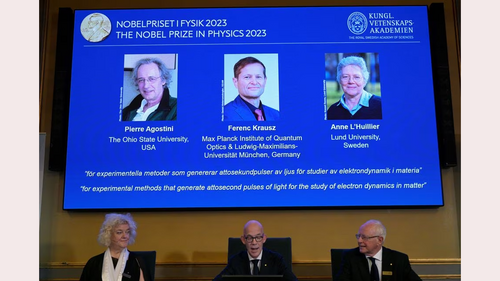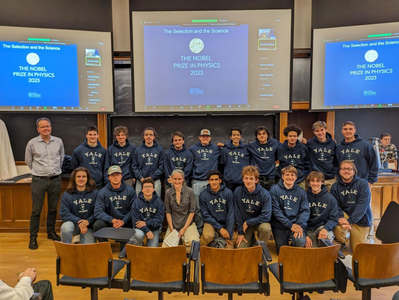
On Monday, October 9, 2023, the Yale Physics Department held its annual undergraduate hoodie ceremony followed by the second annual Nobel Prize in Physics Lecture. This lecture is a way to connect with the undergraduate community by having a talk at their level about the science behind the winners of the Nobel Prize in Physics. This year, the lecture addressed two topics: the selection process, presented by John Wettlaufer, A.M. Bateman Professor of Geophysics and a member of the Nobel Prize Selection Committee; and the science behind the prize, which was presented by Peter Rakich, Professor of Applied Physics. The event was hosted by Sarah Demers, professor and director of undergraduate studies in physics.
 The Nobel Prize lecture was preceded by the undergraduate hoodie ceremony, where members of the junior class, as well as new members of the senior class, who have declared as a physics major, are presented with the physics hoodie. The annual hoodie ceremony began in 2014 in order to acknowledge students who have formally declared as a physics major.
The Nobel Prize lecture was preceded by the undergraduate hoodie ceremony, where members of the junior class, as well as new members of the senior class, who have declared as a physics major, are presented with the physics hoodie. The annual hoodie ceremony began in 2014 in order to acknowledge students who have formally declared as a physics major.
This year’s Nobel Prize was awarded to Pierre Agostini, The Ohio State University; Ferenc Krausz, Max Plance Institute of Quantum Optics and Ludwig-Maximilians-Universitat, Munich; and Anne L’Huillier, Lund University, Sweden, “for experimental methods that generate attosecond pulses for the study of electronic dynamics in matter”.
From the Nobel Prize press release:
Experiments with light capture the shortest of moments
The three Nobel Laureates in Physics 2023 are being recognised for their experiments, which have given humanity new tools for exploring the world of electrons inside atoms and molecules. Pierre Agostini, Ferenc Krausz and Anne L’Huillier have demonstrated a way to create extremely short pulses of light that can be used to measure the rapid processes in which electrons move or change energy.”
After a brief introduction by Sarah Demers, John Wettlaufer started the talk by “describing the timeline and structure of how decisions are made in a given year from the perspective of a member of the committee to try and dispel some of the mythology that is common.” Peter Rakich then “described some of the techniques pioneered by the Nobel prize winners that involve the generation of short pulses of light that are attoseconds in duration. These pulses of light are used to take take snapshots of the internal dynamics of electrons in atoms and molecules, much the same way that short flashes of light are used in stroboscopic photography.
These extremely short (attosecond duration) pulses of light are generated by using intense laser light to strip an electron from an atom giving it a tremendous amount of energy before it recollides with the atom. Through this process each atom emits a very short burst of highly energetic photons that are used to probe electron dynamics at very short timescales.”